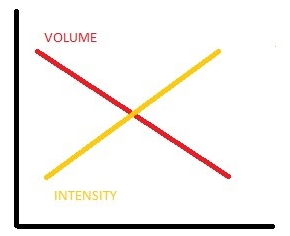Manipulation of volume and intensity
The main way that the coach can control the workload placed on their players is by understanding the relationship between volume and intensity. It is one of the most important relationships to understand when designing training programmes.
Volume is the total amount of activity performed in training (Bompa and Haff, 2009). It can be seen as the duration of training, the distance covered in speed and endurance activities, or as volume load in resistance training which is sets multiplied by repetitions multiplied by weight lifted (Bompa and Haff, 2009).
A technical definition for intensity is the amount of work performed per unit of time, with the more work done per unit of time the higher the intensity (Bompa and Haff, 2009). Heart rate is a common way of measuring intensity in our players as it gives an objective view of how hard the player is working. To simplify, volume can be thought of as how much the player does and intensity can be thought of as how hard they work.
There is an inverse relationship between volume and intensity (shown in the figure below) and this is very important for training programme design. When the volume is high the intensity is generally low and vice versa (Bompa and Haff, 2009). High intensity efforts by their nature cannot be maintained for long durations of training, whereas low intensity efforts can be maintained for long training durations for example, long distance running. It is this trade-off between volume and intensity that the coach must be aware of when designing a training programme. If, for example, the coach fails to consider this and tried increasing both the volume and the intensity then the training load on the players would increase massively which could potentially lead to overtraining and an increased risk of injury.
As training load is essentially volume multiplied by intensity, care must be taken when trying to increase the training load that the plater is able to cope with the increase.
Whether the coach adjusts volume or intensity, or in some cases with more advanced athletes both, can be dependent on the time of the season and the focus of the training during that phase. We will look at the common division of loading at differing times of the season.
